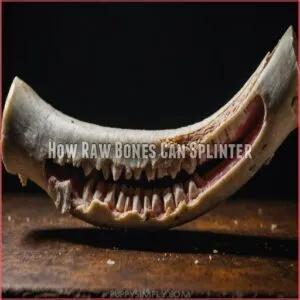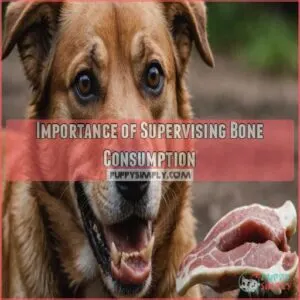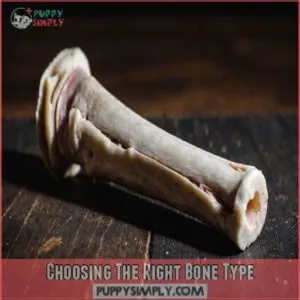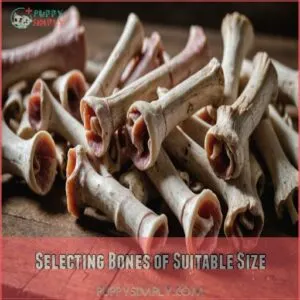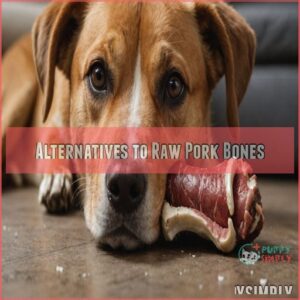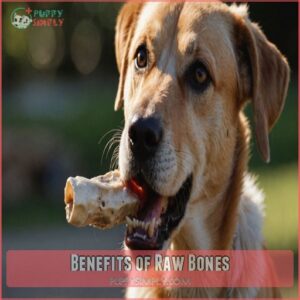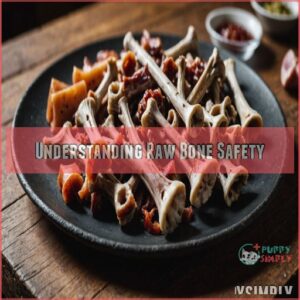This site is supported by our readers. We may earn a commission, at no cost to you, if you purchase through links.
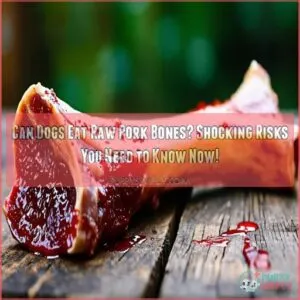 You might think raw pork bones are a tasty treat for your furry friend, but hold your horses! While it’s true that raw bones are less likely to splinter than cooked ones, they still pose risks.
You might think raw pork bones are a tasty treat for your furry friend, but hold your horses! While it’s true that raw bones are less likely to splinter than cooked ones, they still pose risks.
Raw pork bones can harbor nasty bacteria and parasites that’ll have your pup feeling under the weather faster than you can say "fetch." Plus, there’s always a chance of choking or internal injuries.
It’s like playing culinary Russian roulette with your dog’s health! Instead, consider safer alternatives that’ll keep your canine companion’s tail wagging.
Stick around to discover some bone-afide options that’ll have your pooch drooling without the danger.
Table Of Contents
- Key Takeaways
- Risks of Raw Pork Bones
- Safe Bone Feeding Practices
- Alternatives to Raw Pork Bones
- Benefits of Raw Bones
- Dealing With Bone Ingestion
- Understanding Raw Bone Safety
- Frequently Asked Questions (FAQs)
- Can dogs eat pork bones?
- Can one eat pork?
- Can dogs eat raw meat bones?
- Can dogs eat raw pork?
- Why do dogs eat raw bones?
- Are Raw Bones good for dogs?
- Can I give my dog a raw pig bone?
- What raw bones can dogs eat?
- Can dogs eat raw pork?
- How to prepare pork bones for dogs?
- How often should I give my dog raw bones?
- Can puppies safely chew on raw bones?
- Are there breed-specific considerations for feeding raw bones?
- How long can a dog chew on a raw bone?
- Can raw bones help with dental health in dogs?
- Conclusion
Key Takeaways
- Don’t feed your dog raw pork bones – they can harbor harmful bacteria, parasites, and splinter easily, leading to serious internal injuries or choking hazards.
- If your dog has eaten a bone, watch for warning signs like vomiting, lethargy, difficulty eating, or bloody stools – contact your vet immediately if these symptoms appear.
- You’ll find safer alternatives in raw beef or lamb bones, which provide dental benefits and essential nutrients while being less likely to splinter.
- Keep bone-chewing sessions to 15-20 minutes and supervise your dog closely – remove the bone when it becomes small enough to swallow whole.
Risks of Raw Pork Bones
You might think raw pork bones are a tasty treat for your furry friend, but they can be a recipe for disaster.
These bones can splinter and cause serious harm to your dog’s digestive system, potentially leading to costly vet bills and a very unhappy pup.
Why Cooked Bones Are More Hazardous
Here’s the thing about cooked bones: they’re like ticking time bombs for your pup.
The cooking process turns them into brittle hazards that can wreak havoc on your dog’s health.
Consider safer alternatives like raw, durable pork bone dog chews pork bone dog chew.
Let’s break down why these seemingly innocent treats are actually dangerous:
- Tooth damage: Cooked bones can crack
How Raw Bones Can Splinter
Raw bones aren’t off the hook either.
While they’re generally safer than cooked ones, they can still splinter, especially pork bones.
Your dog’s chewing habits play a big role here.
Let’s break it down:
| Factor | Impact on Splinting Risk |
|---|---|
| Bone Density | Denser bones are less likely to splinter |
| Bone Size | Larger bones are safer for big chewers |
| Dog’s Age | Older dogs may have weaker teeth, increasing risk |
Remember, even raw bones can pose choking hazards.
It’s all about knowing your pup’s chewing style and choosing wisely.
Importance of Supervising Bone Consumption
Don’t let your pup out of sight when they’re chomping on bones, especially if you’re giving them pork femur bones risks.
Supervising bone consumption is essential for dog safety.
Keep an eye on their chewing habits to prevent choking risks.
If the bone gets too small or starts splintering, it’s time to step in.
By staying vigilant, you
Safe Bone Feeding Practices
You’ll need to follow specific guidelines to keep your furry friend safe when feeding bones, just as you’d follow a recipe when cooking a special meal.
While raw pork bones aren’t recommended, you can learn the right way to choose, store, and serve other types of bones that’ll keep your dog happy and healthy.
Choosing The Right Bone Type
Let’s make bone selection a breeze for your furry friend’s safety.
Just like you wouldn’t serve a gourmet meal on a paper plate, choosing the right bone texture and density matters for your pup’s wellbeing.
- Beef bones offer ideal density for safe chewing
- Lamb bones provide excellent texture for dental health
- Skip chicken and turkey bones completely
- Avoid pork bones regardless of preparation
Remember, the right bone can mean the difference between a happy chewer and an emergency vet visit.
Selecting Bones of Suitable Size
When choosing bones for your furry friend, size matters more than you might think.
Imagine this: your dog’s head size is your measuring stick for safe bone size – go bigger!
A bone should be longer than your pup’s muzzle and thicker than their jaw can wrap around.
Think of it like picking the right-sized chew toy – too small and it’s a choking hazard.
Storing and Feeding Bones Safely
Your properly-sized bone needs proper storage too! Think of bones like any other fresh food – they need TLC to stay safe for your furry friend. Store them in your freezer until it’s chow time, then pop them in the fridge where they’ll stay fresh for up to four days. Watch your pup like a hawk during bone time for maximum safety.
- Keep bones frozen until you’re ready to serve them
- Never leave bones at room temperature for more than 2 hours
- Remove and discard bones once they’re small enough to fit in your dog’s mouth
- Clean your dog’s bone area with pet-safe disinfectant after each session
- Store thawed bones in an airtight container in the fridge
Introducing Raw Bones Gradually
Taking baby steps with raw bones keeps your pup’s tummy happy.
Start by offering ground bone mixed into their regular food, about a teaspoon for medium-sized dogs.
Be aware that even with gradual introduction, some bones like baby back rib bones can still pose risks to your dog’s health.
After a week of smooth sailing, introduce small raw bones for short chewing sessions.
Think of
Alternatives to Raw Pork Bones
If you’re looking for safer options than raw pork bones, you’ll be happy to know there are plenty of excellent alternatives for your furry friend.
Large, raw beef and lamb bones can provide the same dental and nutritional benefits while being much safer for your dog to chew.
Beef and Lamb Bones as Options
Safe alternatives to pork bones are right under your nose!
Raw beef bones and lamb bones stand out as excellent choices for your furry friend.
These bones pack a nutritious punch while being naturally tougher and less likely to splinter.
Think of them as nature’s dental floss – they’ll keep those pearly whites clean while giving your pup a satisfying chewing experience.
Importance of Bone Density and Size
Consider bone density and size as the golden rules when picking raw bones for your pup.
While beef and lamb bones shine as top choices, the right size matters more than you’d think.
If you’re unsure about the best options, you can find a variety of best chew bones for dogs.
Imagine this – bones should match your dog’s chew strength like a puzzle piece fits its
Avoiding Chicken and Turkey Bones
Between your dog’s chompers and disaster, chicken and turkey bones spell trouble.
These bones splinter like toothpicks, creating sharp hazards that can pierce your pup’s digestive system.
You’ll want to pick safer alternatives that won’t keep you up at night worrying.
| Bone Type | Safety Rating |
|---|---|
| Chicken Bones | High Risk |
| Turkey Bones | High Risk |
| Beef Marrow Bones | Safe Choice |
Benefits of Raw Bones
You’ll find that raw bones are nature’s multivitamin for your dog, packed with essential nutrients like calcium, phosphorus, and collagen that support everything from bone strength to joint health.
While raw pork bones aren’t recommended, other raw bone options can provide these benefits plus a natural way to keep your pup’s teeth clean and their jaw muscles strong.
Essential Minerals and Vitamins
You’ll find nature’s multivitamin packed inside those raw bones, but it’s important to opt for the right bones, such as lamb and goat bones, to guarantee safe dental cleaning.
While pork bones aren’t recommended, other raw bones deliver an impressive nutritional punch for your furry friend.
Their bone marrow‘s like a treasure chest of goodness.
- Calcium and phosphorus work together to build
Improving Dental Health and Digestion
Raw bones act like nature’s toothbrush for your pup, scraping away plaque and tartar while massaging those gums.
They’re packed with natural enzymes that boost healthy gut bacteria and aid digestion.
The gnawing action stimulates saliva production, which helps break down food better. Think of it as a two-for-one deal: your dog gets a dental cleaning while their digestive system gets a natural tune-up.
Supporting Joint Health and Mobility
Just like a natural supplement package, bones contain powerful compounds that support your dog’s joint health.
The glucosamine and chondroitin found in bone marrow work together to maintain healthy joints and improve mobility. Think of these nutrients as nature’s joint supplements!
- Watch your senior dog bounce back with renewed energy
- See your arthritic pup move more freely
- Notice improved flexibility during playtime
- Observe stronger, more stable joint function
Dealing With Bone Ingestion
If you’ve caught your dog munching on a bone they shouldn’t have, don’t panic – there are steps you can take right away to handle the situation.
You’ll need to act quickly and watch for specific warning signs that’ll help you determine if your furry friend needs immediate veterinary care.
Removing Bones From Dogs
When your dog’s having a bone bonanza gone wrong, stay calm and act fast.
Don’t force your furry friend to vomit – this could cause more harm than good.
Instead, offer bread or mashed potatoes to help cushion any fragments.
Keep a close eye on their behavior and contact your vet immediately if you notice any signs of distress or discomfort.
Responding to Choking Emergencies
If your dog’s choking on a bone, stay calm.
First, open their mouth and sweep for visible obstructions. If that doesn’t work, try the Heimlich maneuver: wrap your arms around their belly, just behind the ribcage, and give quick upward thrusts.
For small dogs, hold them upside down and gently shake.
Remember, every second counts in these situations. If you can’t dislodge the bone, rush to the vet immediately.
Monitoring for Signs of Illness
Your quick action can save your pup’s life, but the danger’s not over yet.
Keep a hawk-like watch on your furry friend for the next few days. Here’s what to look out for:
- Vomiting or dry heaving
- Lethargy or unusual behavior
- Loss of appetite or difficulty eating
- Blood in stool or black, tarry stools
Don’t hesitate to ring your vet if anything seems off. Better safe than sorry for your
Understanding Raw Bone Safety
You might think all raw bones are safe for your pup, but that’s not always the case.
Regarding raw pork bones, there are some surprising risks you need to be aware of to keep your furry friend healthy and happy.
Why Pork Bones Are Not Recommended
Pork bones pose a unique threat to your furry friend. Unlike other raw bones, they’re more likely to splinter, causing potential harm.
Let’s break down the risks:
| Risk Factor | Potential Consequence |
|---|---|
| Bone Fragmentation | Mouth/Throat Injuries |
| Splintering | Gut Blockages |
| Density | Canine Dental Issues |
| Size Variability | Choking Hazard |
Veterinary recommendations are clear: it’s best to
Risks of Factory-Farmed Pork Bones
Factory-farmed pork bones pose additional risks beyond typical raw bone dangers.
These bones often harbor harmful bacteria due to cramped, unsanitary conditions.
Music for anxious dogs can be a supportive tool in managing your dog’s stress due to these factors.
Antibiotic overuse in factory farms contributes to antibiotic-resistant superbugs, potentially affecting your dog’s health.
There’s also a higher risk of swine flu transmission.
Remember
Importance of Choosing Pastured Pigs
Raw pork bones vary in quality depending on the pig’s origin.
Pasture-raised pigs offer a safer option for your furry friend. These happy hogs munch on organic feed and roam freely, leading to healthier bones.
Farming practices impact bone quality, leading to better nutrition with regenerative farming methods.
While raw pork bones still pose risks, choosing pastured pigs can help minimize potential health hazards for your pup, because pig welfare matters.
Frequently Asked Questions (FAQs)
Can dogs eat pork bones?
You shouldn’t give your dog pork bones.
They’re too risky, as they can splinter and harm your pup’s mouth or digestive system.
Stick to safer chew options like specially designed dog toys or vet-approved treats instead.
Can one eat pork?
Picture a sizzling slice of bacon, tempting your taste buds.
Yes, you can eat pork! It’s a versatile meat packed with protein and nutrients.
Just make sure it’s cooked thoroughly to avoid foodborne illnesses.
Enjoy in moderation as part of a balanced diet.
Can dogs eat raw meat bones?
Raw meat bones can be safe for dogs, but choose wisely.
Large, thick bones from beef or lamb are best.
They’re less likely to splinter and provide essential nutrients.
Always supervise and avoid cooked bones, which can be dangerous.
Can dogs eat raw pork?
While it’s possible for dogs to eat raw pork, it’s not recommended.
Raw pork can contain parasites and bacteria that may harm your furry friend.
It’s safer to stick with cooked, lean pork in moderation as an occasional treat.
Why do dogs eat raw bones?
You’d think dogs chew bones just to annoy us, but there’s more to it.
They’re following instincts, cleaning teeth, and getting nutrients.
Raw bones offer mental stimulation, dental health benefits, and essential minerals for your furry friend’s wellbeing.
Are Raw Bones good for dogs?
Safe raw bones can boost your dog’s health with essential nutrients like collagen, calcium, and vitamins.
They’ll strengthen teeth, improve joint health, and provide mental stimulation when you choose appropriate sizes and supervise chewing sessions.
Can I give my dog a raw pig bone?
Picture sharp splinters piercing your dog’s throat – that’s the risk with raw pork bones.
Don’t gamble with your pup’s safety.
These bones can splinter and cause serious internal damage, even raw.
What raw bones can dogs eat?
Feed your dog large raw beef or lamb bones, which provide essential nutrients and won’t splinter like other types. They’ll strengthen teeth and jaws while satisfying natural chewing instincts safely.
Can dogs eat raw pork?
You shouldn’t give your dog raw pork due to potential parasites and bacteria that could cause serious illness.
If you want to treat your pup, opt for fully cooked lean pork instead.
How to prepare pork bones for dogs?
In a million years, don’t prepare pork bones for your dogs.
These bones are extremely dangerous, as they’ll splinter easily and can cause fatal injuries.
How often should I give my dog raw bones?
Limit raw bone treats to twice weekly, spacing them 3-4 days apart.
Watch your pup’s chewing time to 15-20 minutes per session.
Store extra bones in the freezer between uses for safety.
Can puppies safely chew on raw bones?
Starting your puppy’s raw bone journey requires caution.
While raw bones offer dental benefits, wait until they’re 6 months old.
Choose large, thick bones to prevent choking, and always supervise their chewing sessions closely.
Are there breed-specific considerations for feeding raw bones?
You’ll need to match bone size to your dog’s breed.
Larger bones are suitable for big breeds like German Shepherds.
Smaller bones are suitable for tiny pups.
Consider their chewing strength and jaw size when selecting.
How long can a dog chew on a raw bone?
In a flash that’ll make your head spin, don’t let your dog chew raw bones longer than 15-20 minutes at a time.
Remove the bone when it’s small enough to swallow whole.
Can raw bones help with dental health in dogs?
Raw bones can naturally clean your dog’s teeth and gums by scraping away plaque and tartar.
They’ll also strengthen jaw muscles and satisfy your pup’s natural urge to chew, promoting better dental health.
Conclusion
Just as a ship’s captain carefully charts their course through dangerous waters, you’ll want to navigate your dog’s dietary choices with equal care.
While raw pork bones might seem like a natural treat, they’re simply not worth the risk to your four-legged friend’s health.
Instead of wondering "can dogs eat raw pork bones," focus on safer alternatives like specialized dental chews or vet-approved recreational bones.
Your pup’s health and safety should always be your compass when choosing treats.


